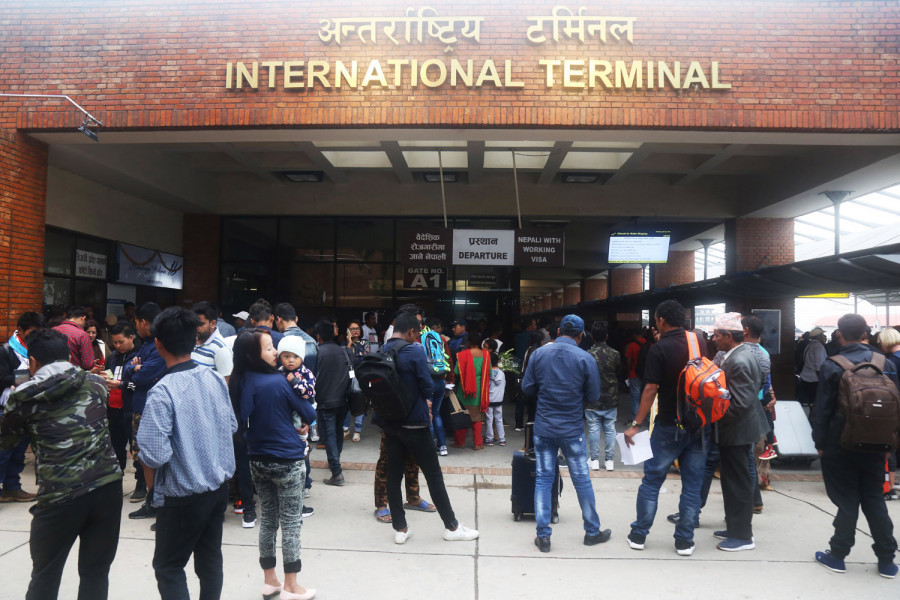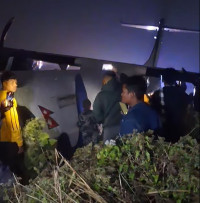National
Covid-19 restrictions once again cast uncertainty over labour migration
After a disastrous 2020 when labour migration dropped to a new low, the foreign employment sector has once again started to feel the heat amid surge in Coronavirus cases.
Chandan Kumar Mandal
Nepal’s labour migration sector, which was hit hard by the Covid-19 pandemic last year and was slowly back on a path to recovery, is once again staring at an uncertain future with the second wave of the pandemic gripping the country.
In recent weeks, the government has been introducing a slew of restrictions for containing the virus, which is spreading at an alarming rate. These restrictions have once again affected all spheres of public life and the economy.
With the government suspending international flights from midnight Wednesday, Nepali migrant workers will not be going to work abroad, at least for some time.
The government, on Sunday, decided to halt all domestic flights from Monday midnight and all international flights from Wednesday midnight until May 14 in view of the sharp spikes in Covid-19 cases in the country.
According to Sujeet Kumar Shrestha, general secretary of Nepal Association of Foreign Employment Agencies (NAFEA), a grouping of recruiting agencies involved in hiring and supplying Nepali migrant workers to foreign employers, the decision to suspend international flights, will be severely damaging for the foreign employment sector.
“Although labour destination countries are still open, Covid-19 cases have been rapidly increasing in Nepal and neighbouring India and this has prompted the government to stop international flights for now,” said Shrestha. “This is yet another blow to the foreign employment sector which had not fully recovered from several months of flight suspension last year.”
In March 2020, when the first wave of Covid-19 hit the labour destination countries mainly in the Gulf, Malaysia and South Korea, among others, the government had halted labour migration barring its citizens from flying abroad for work. Before the government would allow Nepalis to take up jobs in the destination countries, the damage was already done.
The months-long suspension of labour migration resulted in a massive decline in migrants leaving the country. The number of labour permits issued to migrant workers had slumped to a new low in the last fiscal year. Nepal recorded a drop of 27.5 percent in labour permits in 2019/20 compared to the year earlier.
According to the Department of Foreign Employment, 368,433 labour permits were issued to aspiring migrant workers during 2019/2020, which was the lowest in the last five years.
“Last 14-15 months had been terrible for the foreign employment sector when we could not send workers because of the restrictions and a fall in demand,” said Shrestha. “Last fiscal year, 536 recruiting agencies could not meet the government threshold of sending a minimum of 100 workers in a year for renewing their license. This fiscal year, just 123 agencies have been able to cross the threshold. This alone shows how grim the situation is for the sector.”
The association, however, says it cannot immediately say how many prospective migrant workers will be affected by the new suspension of international flights.
But the impact has been already felt at the government offices which issue labour permits to outbound migrants. The Department of Foreign Employment, the government body overseeing the labour migration sector, says there has been a gradual drop in the number of Nepali workers leaving the country since the past few months.
“We have witnessed a decrease in the number of migrant workers going abroad recently,” Krishna Prasad Dawadi, director general with the department, told the Post on Sunday afternoon before the cabinet decided to suspend international flights. “We can’t give exact figures immediately, we have been told by the Labour Desk at the Tribhuvan International Airport that fewer people are migrating for work.”
Although the suspension on international flights was announced only on Monday, various districts across the country are already under prohibitory orders since last week and this has also affected the movement of workers to Kathmandu.
Starting from last Thursday, human movement and gatherings have been banned while public and private vehicles are not allowed to ply the roads for 15 days.
But Dawadi said his office in Kathmandu had made arrangements for providing labour permits to outbound workers if they face any difficulties in reaching the office.
“For providing labour permits to migrant workers, who have booked their flight tickets and hotel quarantines in destination countries but are unable to reach the government office for labour permits due to the prohibitory orders, we have arranged passes for recruitment agencies operators,” said Dawadi. “The recruiting agencies can collect the labour permit on behalf of such migrant workers. Although we have not analysed the latest data on labour permits issued, ongoing travel restrictions, quarantine compulsions upon landing in destination countries and added expenses on the part of employers could be the possible reasons behind the recent decline in labour migration.”
The drop in foreign migrant numbers is evident from the records at the Foreign Employment Office, Tahachal, which issue labour permits to migrant workers.
The office has significantly sliced its daily quota of new labour permits for those who visit the office in-person and submit applications. The applications can also be submitted online.
According to Chhatra Prasad Shah, director at the Foreign Employment Office, Tahachal, since the imposition of the prohibitory orders, they have limited the daily issuance of labour permits to in-person applicants to 100 from the previous 600.
Online applicants receive labour permits within three days of submitting their applications.
“We have changed the maximum daily quota for both offline and online applicants since the imposition of the latest prohibitory orders,” said Shah. “While we decreased the number of permits issued to offline applicants, we have increased the same for online applicants to 200 daily from the previous 350, to encourage people to apply online.”
Shah, however, added that workers whose biometric details have not been registered before must visit the office physically for labour permit, whereas migrant workers who are on their work break can apply online for a re-entry labour permit.
“The labour destination countries are still allowing Nepali migrant workers. Likewise, there are workers who are in Nepal on annual vacation or work breaks are fearful of being stuck in Nepal if the international flights are suspended for long,” said Shah. “So people from this category are more keen on seeking labour permits now.”
After months of hiatus, when the government resumed labour migration in phase-wise manner in June last year, demand for Nepali workers had started trickling in.
Although demands were in smaller numbers in the early months of resumptions, it had given some hopes for a revival of the labour migration sector. But, some countries like Kuwait have still not allowed Nepalis and complication in attestation of worker demand letters by the Nepali missions had caused problems in sending workers in recent months.
However, in the last few months, there had been a steady growth in the number of Nepali workers heading abroad. In the first nine months of the ongoing fiscal year, 117,592 labour permits were issued and nearly 45 percent or 51,950 permits were issued in the last two months, showing signs of recovery.
A total of 32, 142 Nepali migrant workers—30,035 male and 2,107 female—had received labour approvals for working in as many as 73 labour destination countries in the month of Chaitra [March 14-April 13]. It was a substantial increase compared to a month earlier when 19,808 permits were issued.
“Demand for Nepali workers was improving. We had expected demand for around 50,000-60,000 from Saudi Arabia and around the same number from Qatar,” said Shrestha, the general secretary of Nepal Association of Foreign Employment Agencies. “Now, suddenly everything looks uncertain once again.”




 17.12°C Kathmandu
17.12°C Kathmandu










%20(1).jpg&w=300&height=200)



